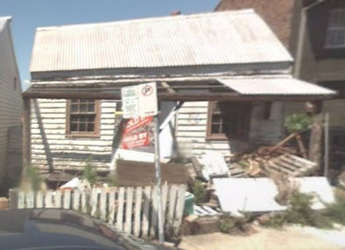On location with the Bloke
| In October 1915
the sequence of poems entitled
The Songs of a Sentimental Bloke
by Australian poet and author
C. J. Dennis
was published as a book,1 which was an immediate popular and critical success.
Two and a half years later the motion picture-making pair of
Raymond Hollis Longford
and Lottie Lyell
set about transferring a version of the story to the screen.2
Dennis set the tale in Melbourne, but Longford and Lyell shot most of the scenes in Sydney where they were based and which they knew well. But because they did not include any geographical reference in the text of the intertitles, the settings become universal – as is the story. The film was made, for the Southern Cross Feature Film Company, Limited of Adelaide, South Australia, between May and November 1918, and most of the shooting in Sydney was done between May and August.3 In early April Dennis went to Adelaide to finalise arrangements for the production.4 At the end of May Longford was in Sydney working on the film,5 and was back in Adelaide by early September.6 The first known showing of the film was at a preview given at the Wondergraph Theatre, Adelaide on the morning of 26 November 1918.7 It did not, however, get a public release until 4 October 1919 when it was shown at Melbourne Town Hall, and on 18 October at the Theatre Royal, Sydney. |
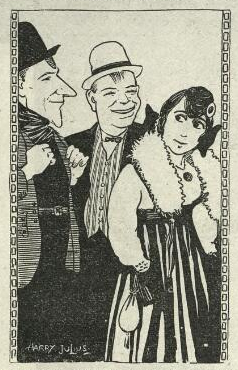
Sketch by Harry Julius8 Image courtesy of the National Library of Australia |
The scenes in the film are listed below. For exterior shots the locations, if they have been determined, are noted. "Interior" scenes were, according to Longford, filmed on the site of William Anderson's defunct Wonderland City at Tamarama: the sets were open to sunlight to obtain adequate illumination for the slow film of the time.9
Most shots are relatively narrow-angle and camera movements are kept to a minimum, which result in there being little location context presented for the action. This has made it difficult or impossible to determine several of the locations.
If you know any location in the film that has not been identified below, please let me know.
The National Film and Sound Archive of Australia (NFSA) has produced a restored version of the film in digital format as part of its NFSA Restores program. Several very short excerpts from this are available online, and are linked to at the appropriate points in the following list. I am very grateful to the NFSA for giving me access to high-resolution copies of the film, which has enabled the determination of the locations of further scenes.
The times below – hours:minutes:seconds – are taken from a copy of the film on YouTube; they might be incorrect by a second. This copy runs about 1½ times as fast as it should: the original film would have been shown at approximately 16 frames per second, whereas the YouTube frame rate is 25 frames per second.
- 0:00:00 : main titles
- 0:00:24 : C. J. Dennis "at work", writing at a desk
- 0:00:41 : exterior view of the front door of the Sentimental Bloke's home
The street number (on a disc on the door) is 23, and the street is Berwick Lane, Darlinghurst. The house is still standing, though the facade has been modified.10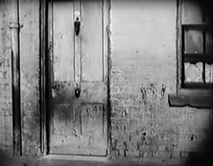 Frame detail from YouTube copy
Frame detail from YouTube copy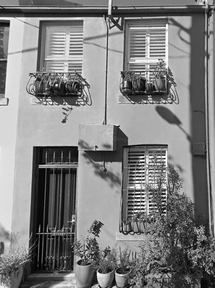 Image courtesy of Google, Inc.
Image courtesy of Google, Inc. - 0:00:43 : the Bloke (whose name is "Bill") at his front door
The Bloke is portrayed by Arthur Tauchert. - 0:01:02 : Ginger Mick, the Bloke's mate,
comes out of his house, across the road from the Bloke's
Ginger is played by Gilbert Emery. His house is 26 Palmer Lane (previously Little Palmer Street); the buildings there were demolished (along with adjoining 28 Palmer Lane) in 1946.
There is a continuity error in this sequence of shots: Ginger's front door is open to start with, then closed in a close-up shot, and then open again. - 0:01:23 : inside a pub
- 0:01:30 : leaving the pub
The pub is possibly the Grand National Hotel, on the eastern corner of Underwood and Elizabeth Streets, Paddington. A poster advertisement for TOOTH'S XXX ALE & STOUT (with brewers Tooth and Co.'s emblem of a rearing horse) is seen outside the pub. - 0:01:42 : arriving at the two-up school
There is indistinct writing – probably a faded business name – on the gates. - 0:01:47 : intertitle:
Jist 'eadin 'em, an' doin' in me gilt.
- 0:01:50 : various shots in the yard of the two-up school
- 0:01:52 : Two up (NFSA Restores version)
- 0:02:05 : outside at the gates
- 0:02:14 : inside again
- 0:02:21 : police arrive outside
- 0:02:25 : the police enter through the gates and break up the game – the participants (attempt to) flee – various shots
- 0:02:41 : two players climb a wall and onto a roof, followed by a policeman
- 0:02:43 : The great escape (NFSA Restores version)
- 0:02:48 : the three on a roof,
which is a different one from that of the previous shot
(though they are adjacent).
A church steeple is visible (through the haze) in the background. - 0:02:58 : man climbing down wall into street, to be met by a policeman
A TO LET sign can be seen: is this why Longford was able to use this location? - 0:03:02 : the Bloke fighting police
- 0:03:04 : horses, and Ginger Mick
Ginger's coattail is not completely pulled under the hay and is still visible!
This location could well be on the east side of Woolloomooloo. - 0:03:05 : Hiding in the hay (NFSA Restores version)
- 0:03:21 : guy climbing gate caught by police
- 0:03:30 : the Bloke is caught by 2 policemen
- 0:03:40 : Ginger Mick emerges from the hay
- * The DVD version of the film from the NFSA
has an additional scene at this point:
the Bloke is led to and put in a van, with PATROL written on its side,
by a single uniformed man.
This scene is at odds with the other scenes in the sequence of the raid of the two-up game:
the man's uniform is very different from that worn by all the other police in the
sequence, and it is only one man with the Bloke, whereas at all other times
he resists strenuously the efforts of 2 policemen who are needed to control him.
The Kid in gaol (NFSA Restores version) - 0:03:47 : outside a police station
The building is Woolloomooloo Police Station that was on the south-west corner of Riley and Cathedral Streets, Woolloomooloo.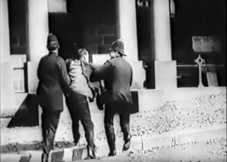 Frame detail from YouTube copy
Frame detail from YouTube copy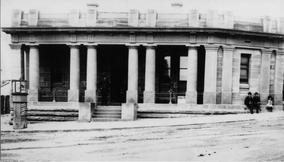
- 0:03:53 : into gaol
This shot may be of the cells inside Woolloomooloo Police Station. - 0:04:28 : gaol gates
This shows the old cast iron gates at the Forbes St entrance to Darlinghurst Gaol. They are no longer there. (The building complex was at the time managed by the Commonwealth Department of Defence.)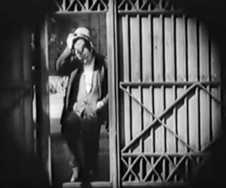 Frame detail from YouTube copy
Frame detail from YouTube copy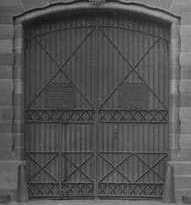
- 0:04:48 : entrance to garden
This is the main gate of the Royal Botanic Gardens, on the southern boundary, off (then) Fig Tree Avenue. In 1962 the structure was moved around the corner to the eastern boundary, off Mrs Macquarie's Road, and is now known as the Woolloomoolloo Gate.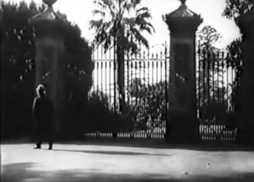 Frame detail from YouTube copy
Frame detail from YouTube copy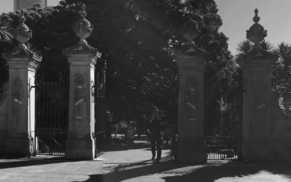 Image courtesy of Google, Inc.
Image courtesy of Google, Inc. - 0:04:52 : the Bloke walking to sit on a bench
in the garden
This is beside one of the several ponds in the Gardens. - 0:06:07 : another view in the garden – girls in white
– fountain
This shows part of what was once known as the Main Walk of Adelaide Botanic Garden. The fountain is no longer there. This was probably an actuality shot.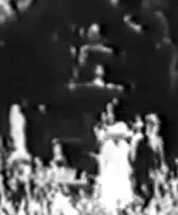 Frame detail from YouTube copy
Frame detail from YouTube copy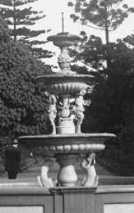
- 0:06:09 : the Bloke on the seat
- 0:06:37 : he gets a job hawking (exterior shot)
- 0:06:46 : the Bloke's first encounter with Doreen
(played by Lottie Lyell)
This appears to have been filmed in a market.11
There is a continuity error in this scene: the woman selling hats behind the Bloke has a potential customer who is first seen trying on a hat, but shortly after comes in to do so. - 0:07:45 : medium close-up of the Bloke, with chap trying on hat
- 0:07:49 : longer view of the Bloke
- 0:07:50 : guy comes in to try on hat
- 0:07:58 : leaving the market
There is a sign for VANILLA ICE-CREAM from the FRESH FOOD & ICE CO. behind. - 0:08:04 : Sunrise
The Sun is coming up over mountains, so this view was probably shot in Adelaide. - 0:08:25 : an actuality scene, looking south towards Central Railway Station, Sydney
- 0:08:31 : Doreen leaving her house
The address of the house is 12 South Street, Edgecliff. (This location is close to that of Spencer's Pictures Ltd's studio at Rushcutters Bay.) The building seen in the film is no longer standing but it was still (just) there in December 2007, as seen in the Google Street View image below.In later (in the film) views of the front of Doreen's (and Mar's) house, a birdcage (with bird) and an ornamental fern are sometimes on the front wall, sometimes not; and the curtains visible in the front window also change between scenes.
- 0:08:37 : the Bloke with cart in a street.
Doreen appears on the way to work, and again spurns the Bloke's advances
The street runs roughly east-west. - 0:09:14 : Doreen going to work, with the Bloke following
The street goes uphill to the north so is almost certainly not in Darlinghurst or Woolloomooloo; it may be Forbes St, Darlington, running parallel to Golden Grove St – see at 0:11:29 below. - 0:09:26 : at entrance to the pickle factory
- 0:09:27 : first appearance of the (other) Bloke
The other Bloke is played by Stanley Robinson. - 0:10:21 : the Bloke in a street with the hawker's cart
- 0:10:56 : inside the pickle factory – Doreen at work
Visible on the back wall is SOUTHAN'S PICKLES. W. M. Southan & Co. had a pickle and sauce factory in Lachlan St, Waterloo, which is probably where this interior shot was taken. As Lachlan St is flat, it was not where the exterior shots, supposedly of the entrance to the factory, were filmed. The name Notting Pickles is written on boxes behind Doreen, and the labels Doreen is putting on the bottles say Notting and Co., although almost no mention of this name exists in contemporary documents. - 0:11:11 : Sunset
The sign PADFIELD'S MOTOR WORKS is seen on the side of a building: Herbert Webb Padfield had a motor garage at Wyatt St, Adelaide. The tower on the right side of the picture appears to be that of the Adelaide General Post Office, while that on the left is likely the spire of the Presbyterian church in Flinders St, which was demolished in 1957. - 0:11:21 : workers leaving the pickle factory
The Bloke's mate and Doreen converse and then walk north. It is windy and most likely overcast, as there are only very faint shadows. - 0:11:29 : the Bloke waiting
I.X.L. JAMS. is written on the wall of the building in the background.
The street is Golden Grove St, Darlington and the building is the Sydney factory of H. Jones & Co., jam and sauce manufacturers and fruit canners. The building was demolished between 1979 and 1984, and a housing complex built in its place.
There are strong shadows.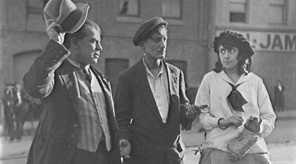 Image courtesy of the NFSA
Image courtesy of the NFSA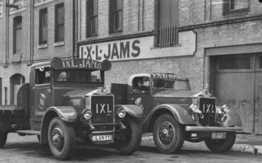
- 0:11:30 : view of a street corner
Doreen and the other bloke appear, turn the corner, and walk east towards the camera. The Sun is out. The fellow's jacket is buttoned, whereas it wasn't in the scene at 0:11:21. - 0:11:38 : the introduction
The Bloke is waiting (as at 0:11:29) and Doreen and friend appear from the right and walk south to meet him. (Doreen and the other chap walk north, then east, and then south, and must cross a road, in going from the factory entrance to meet the Bloke.) Possibly all the shots of this sequence were filmed in the area of Darlington around the H. Jones & Co. factory.12 - 0:12:07 : a carriage goes past: on it are signs for Zetz-Spa; mineral and aerated waters; Tooth and Co. The Zetz-Spa springs, run by Tooth and Co., were at Ballimore, near Dubbo, NSW.
- 0:13:20 : days drag by – street scene – hawking
The location is outside numbers 8 and 10 Palmer Lane, Darlinghurst.13 The houses seen in the film are still standing.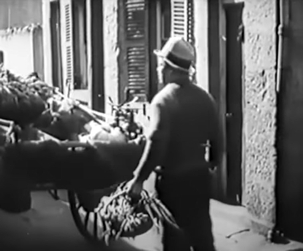 Frame detail from YouTube copy
Frame detail from YouTube copy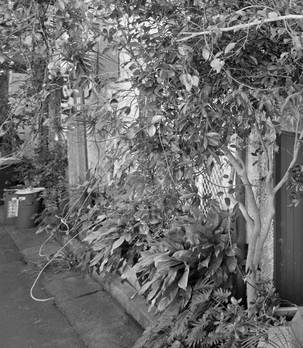 Image courtesy of Google, Inc.
Image courtesy of Google, Inc. - 0:13:58 : Ginger Mick and friends outside a pub
The decoration of the walls and the Tooth's poster match those of the pub seen early in the film (at 0:01:30). - 0:14:17 : the Sunday night meeting
In a street with suburban (rather than city) buildings seen in the distance. (From the shadows the view is roughly to the south-west.)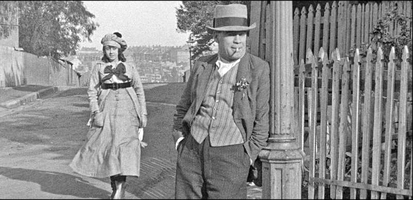
Waiting for the first dateImage courtesy of the NFSA - 0:14:40 : the Bloke and Doreen on a ferry
In a shot showing the boy selling chocolates, etc Fort Denison is seen in the background. - 0:14:54 : Ferry to Manly (NFSA Restores version)
Lottie is a litterbug: she tears the wrappers from her chocolate bar and lets them go to be blown away by the wind. - 0:15:22 : Moonlight on water
Longford confirmed that this is a day-for-night shot, and the "Moonlight" in the film is Sunlight through a strong filter. The dark sky with Moon and stars has been superimposed. - 0:15:42 : the bandstand at the beach
A newspaper article14 states that the rotunda was at Henley Beach, Adelaide. The building was demolished long ago.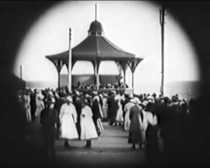 Frame detail from YouTube copy
Frame detail from YouTube copy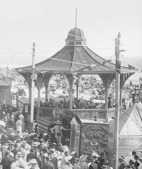
But why was this scene included? There are two men who appear obvious in this sequence; were they involved in the film's production – directors of the Southern Cross Feature Film Company?
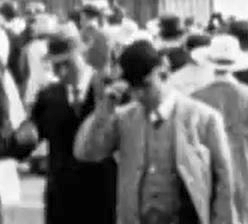
At the Henley Beach rotunda: who were these two men?Frame detail from online copy - 0:15:46 : the Bloke and Doreen sitting on the sand
At Manly beach, Sydney. - 0:15:51 : women walking along promenade
At Manly. Did the five women give their permission to be filmed? - 0:15:52 : sitting on the sand
- 0:16:49 : a fisherman watching the couple
- 0:16:51 : sitting on beach – end of kiss – and fisherman
- 0:16:54 : Romance at Manly beach (NFSA Restores version)
- 0:16:56 : a repetition of the view of
the Henley rotunda (but truncated by a few frames)
- 0:16:58 : on the beach
This is Manly beach or North Steyne beach; the nearer headland in the background is Queenscliff and the further one is at the north end of Freshwater beach. - 0:17:08 : the pair walking along the beach
- 0:17:36 : outside Doreen's house
- 0:17:59 : the Bloke at his new job in a printing business
This is a proper interior shot. - 0:18:18 : Shakespeare's Romeo and Juliet at the theatre
For more about this see below. - 0:22:19 : the portal of the theatre, with people leaving
The theatre is the Palace Theatre, which was at 261a Pitt St. This is an actuality shot, presumably taken after a matinee performance there. In the extant copy of Longford's scenario for the film this is Scene 60, and the Bloke and Doreen were to have been included in the exiting crowd. Note that there are many soldiers in uniform.
Partially seen in the foyer is a sign for EMELIE POLINI, who was an English actress who had the title role in the play De Luxe Annie at the Palace Theatre from 27 April through 24 June 1918 (and later, after 21 September 1918), so it is almost certain that the exiting audience had been to see this play.
The shot was probably taken from The Banking House, across the road at 228 Pitt St, where the Australian Variety and Show World magazine, E. J. Carroll, and J. & N. Tait had their offices. Variety and Show World, who kept readers up-to-date with Longford's activities, were on the first floor, which appears to be the level of the camera.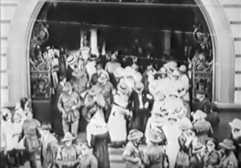 Frame detail from YouTube copy
Frame detail from YouTube copy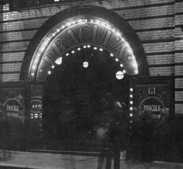
- 0:22:27 : the Bloke and Doreen enter a shop
The key to identifying this location is TEL. 705 WAV. written on the window. Sydney telephone directories circa 1918 assign the number to A. Peluso, fruiterer and confectioner, of Hall St, Bondi; Sands' directories and NSW electoral rolls confirm that Antonio Peluso (and his wife Giovannina) had a shop on the southern corner of Hall St and Bondi Rd (now named Campbell Parade), Bondi.
Trams can be seen in reflections in the windows of the shop, and indeed just a little further north on Bondi Rd was the terminus of the Bondi tram line.
The shop and adjacent premises, much modified, are now (2023) a boutique hotel, Ravesi's. The Ravesis took over the corner-shop business in 1920. - 0:22:28 : a drink – milkshake? – at the shop
Ginger Mick and the Stror 'At Coot (acted by Harry Young) are already there.
This purports to be outside behind the shop, but may have been any convenient exterior location. - 0:23:47 : another, longer view of the entrance to the shop
Again, reflections of trams are seen in the windows. - 0:24:21 : street corner near Doreen's house
This is a view south down Melia Lane, Edgecliff, from the intersection of Artlett St with South St. What is now known as Trumper Park is visible in the background. The nearest building on the left is still standing. Doreen's and Mar's house is along South St, to the right – see at 0:08:31.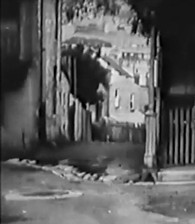 Frame detail from YouTube copy
Frame detail from YouTube copy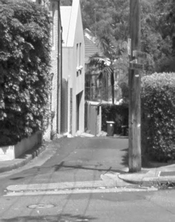 Image courtesy of Google, Inc.
Image courtesy of Google, Inc. - 0:24:50 : in the street at Doreen's house
- 0:25:37 : the Stror 'at Coot waiting for Doreen
AUSTRALIA is moulded on the lamppost. - 0:25:39 : Doreen coming out her front gate
- 0:25:41 : the Stror 'at Coot again
- 0:25:45 : Doreen walks up the street – the Coot comes over
Someone looks out from an upstairs window, then withdraws.
The directions of the shadows do not match with the action in this and the previous scenes. - 0:25:55 : the Bloke waiting in a reserve
- 0:25:59 : reverse shot – Doreen arriving with the Coot
- 0:26:01 : the Bloke is annoyed to see them together
- 0:26:14 : reverse shot again
- 0:26:17 : the Bloke – the other two arrive
- 0:27:13 : reverse shot – close-up of the Bloke
There are further alternating shots. - 0:28:41 : the Bloke is thrown out of a pub
This appears to be a different pub from the one seen earlier. - 0:28:53 : at the Bloke's front door
- 0:28:57 : young boys in doorway laughing at the drunk Bloke
- 0:28:58 : going inside
- 0:29:00 : in his bedroom
- 0:29:27 : The Tragedy dream sequence
The location of this scene is on the rocks just to the north-east of Tamarama beach; the headland behind is Mackenzies Point.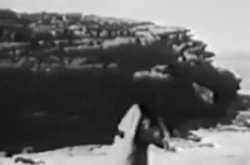 Frame detail from YouTube copy
Frame detail from YouTube copy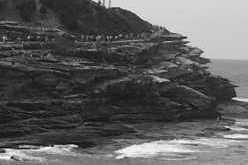 Image courtesy of Simon Fisher
Image courtesy of Simon Fisher - 0:29:45 : the Bloke rolls out of bed and wakes up
- 0:30:35 : leaving home by the front door
The shadows are much the same in the "morning" as in the previous "evening". - 0:30:55 : the Bloke and Ginger Mick, selling rabbits,
meet at a corner
The view is facing east along O'Briens Lane, Darlinghurst at the corner with Palmer Lane, with Bourke St in the background. The building in the right foreground is still standing.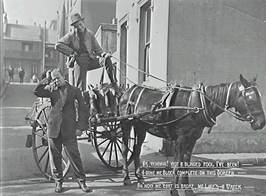 Image courtesy of the NFSA
Image courtesy of the NFSA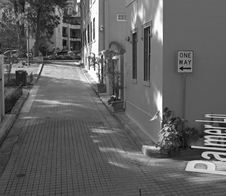 Image courtesy of Google, Inc.
Image courtesy of Google, Inc. - 0:31:11 : close-up of Ginger Mick
- 0:31:23 : medium shot
- 0:31:34 : Ginger Mick continues on his way with his rabbits
Ginger has turned into Palmer Lane, Darlinghurst and is heading south; Berwick Lane is at the end.15 The house visible in Berwick Lane beyond the end of Palmer Lane is the Bloke's home.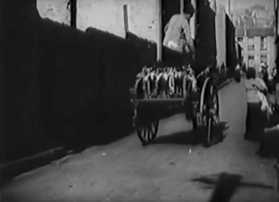 Frame detail from YouTube copy
Frame detail from YouTube copy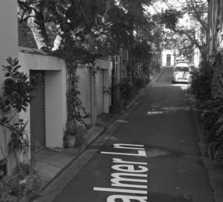 Image courtesy of Google, Inc.
Image courtesy of Google, Inc. - 0:31:46 : inside the printer's – Bloke day-dreaming
- 0:32:01 : Doreen pasting labels on pickle jars
- 0:32:10 : Bloke and Ginger Mick outside Bloke's house
- 0:32:25 : outside door of house of singalong party
- 0:32:35 : inside party house
On a wall in the background there is a picture of a man with a bottle: this picture reappears in the scene at 0:59:49. - 0:33:04 : cover of sheet music of The Curse of an Aching Heart
This song was popular in the USA in 1914, and in Australia was featured in the pantomime The Babes in the Wood late that year and early in 1915, where it was performed by Josephine Gassman and her troupe of piccaninnies.
(Nothing has been found suggesting that audiences at screenings of The Sentimental Bloke sang along, following the words on the screen.) - 0:35:02 : leaving party house
- 0:35:18 : in street on way home
- 0:35:33 : in another street on way home
- 0:35:41 : in a reserve – creek, and post and rail barrier
- 0:36:14 : the Bloke looking back – high paling fence behind him
- 0:36:18 : Doreen will have him back
- 0:36:46 : outside Doreen's house
- 0:37:34 : Bloke inside at home reading book on etiquette
- 0:37:55 : Sunday Night – outside Doreen's
- 0:37:58 : view down street with the Bloke arriving
There is a small boy watching at a gate; he steps out of the gateway and walks in the opposite direction to the Bloke. - 0:38:02 : at gate of Doreen's house
- 0:38:43 : Mar – long interior sequence
Mar is played by Margaret Reid. - 0:43:27 : at gate outside Doreen's house
- 0:43:35 : Mar watching from inside
- 0:43:37 : at gate again
- 0:43:47 : Mar and Doreen inside
- 0:43:49 : the Bloke walking away down the street – takes off a shoe
- 0:44:10 : Bloke with Ginger Mick preparing for wedding
- 0:44:16 : Doreen in wedding dress, also preparing
- 0:44:23 : Bloke and Ginger Mick
- 0:44:33 : in church: the marriage
This was not taken in a church: a publicity still held by the NFSA shows much of the background is painted; also note that the attendees are standing, because there are no pews.
The parson is played by Charles Keegan.
I suspect that one of the people who appear in the various scenes of the wedding and after is Lottie's younger sister, Lynda Marion Cox. - 0:46:39 : leaving the church
This is St Mark's church, on the corner of Greenoaks Ave and Darling Point Rd, Darling Point.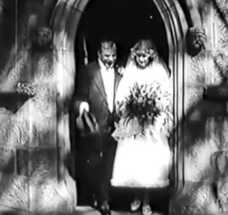 Frame detail from YouTube copy
Frame detail from YouTube copy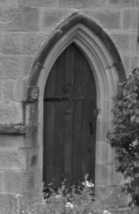 Image courtesy of Google, Inc.
Image courtesy of Google, Inc. - 0:46:42 : wedding group walking beside church
- 0:47:00 : beano at Mar's: celebrations after the marriage
- 0:48:11 : the couple leave Mar's
- 0:48:29 : the party continues at Mar's
- 0:48:36 : a view from outside Central Railway Station looking north towards Pitt St
- 0:48:42 : the couple rush onto the train
- 0:48:55 : in the train carriage
- 0:48:59 : Party time (NFSA Restores version)
- 0:49:04 : the party at Mar's is now in full swing
- 0:49:19 : first view of the newly-weds' home, named Preston
It is very likely that this property was in Fletcher Street, Bondi.16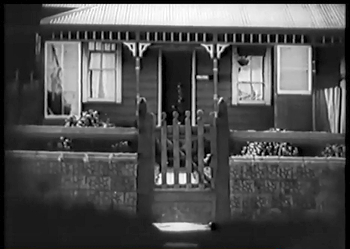
The newly-weds' home, "Preston"Frame detail from YouTube copy - 0:49:24 : inside Preston
- 0:49:49 : the Bloke meets his mates outside a pub
This is a different pub from the one seen earlier, and appears more up-market. - 0:50:14 : inside the pub
- 0:50:18 : outside the pub
- 0:50:33 : inside Preston; Doreen is getting anxious
- 0:50:41 : leaving the pub
The previous shot where the men enter the pub and this one where they leave are not as different in time as we are meant to believe: the shadows in each scene are almost the same in length and direction. - 0:51:28 : Doreen is more anxious
- 0:51:31 : at the 2-up school
- 0:51:39 : Doreen anxious outside Preston
- 0:51:44 : playing 2-up
- 0:52:25 : leaving Steeny's 2-up school
- 0:52:49 : Doreen anxious inside
- 0:52:51 : the Bloke arrives at his front door
- 0:53:04 : inside
- 0:54:08 : next morning – inside
- 0:55:12 : inside Mar's – she takes ill
- 0:55:16 : outside Mar's
- 0:55:18 : 'across the street' from Mar's
- 0:55:20 : outside Mar's
- 0:55:28 : inside Mar's
- 0:55:32 : outside front door of Preston
- 0:55:42 : Mar is dead
- 0:55:47 : arriving outside Mar's
- 0:55:49 : inside Mar's
- 0:56:31 : inside Preston
- 0:56:47 : leaving front door of Preston – the postman arrives
- 0:56:54 : back inside Preston – Uncle Jim's letter
- 0:57:09 : full view of the letter
The address on it is Apple Gully. - 0:57:27 : inside Preston
- 0:57:35 : train arriving at (presumably) Central Station
The number of the locomotive is 462. - 0:57:47 : close-up of Uncle Jim at the carriage door
Uncle Jim is played by William James Coulter. - 0:57:50 : Uncle Jim gets out of the train; Doreen and the Bloke arrive and greet him
- 0:58:34 : inside – discussion with Uncle Jim
- 0:58:42 : first view of Uncle Jim's farm
This was, according to Longford, Mrs. Harrington's orchard and farm in Hornsby Valley, also known as Old Man's Valley, to the west of Hornsby.17 - 0:58:48 : inside – continuing discussion with Uncle Jim
- 0:59:30 : arriving by horse-drawn cart at the farm
- 0:59:34 : view of farm
- 0:59:47 : view of the verandah of the farmhouse
- 0:59:49 : inside the farmhouse
- 1:00:37 : ploughing at the farm
- 1:00:51 : feeding chickens
- 1:01:08 : further ploughing
- 1:01:14 : outside the stables at the farm
- 1:01:18 : inside the farmhouse
- 1:01:45 : leaving the farmhouse to get the doctor
Several trees in blossom are seen. - 1:01:52 : outside the doctor's house – a suburban setting
There is a sign for DR. T. BONNER on the gate – and the doctor is played by Sydney pressman Robert Bonar. - 1:02:06 : leaving the doctor's to get the nurse
- 1:02:11 : at the nurse's – another suburban setting
There is a sign on her gate: NURSE BRADY | CERTIFICATED.
Helen Fergus plays the nurse. (Lottie's maternal grandmother is named Elizabeth Brady.) - 1:02:38 : leaving the nurse's
- 1:02:51 : returning on the track to the farm
All following scenes are on the farm, either outside or in the farmhouse. - 1:02:54 : arriving at the farmhouse
- 1:03:07 : inside the farmhouse
- 1:03:52 : the doctor arriving at the farm
- 1:03:54 : inside the farmhouse; the doctor enters
The door to the outside is, viewed from inside, hinged on the right. - 1:04:15 : the Bloke comes out of the house
onto the verandah
The door into the house is, viewed from outside, hinged on the right – so obviously this door and the one in the previous scene are not the same. This is understandable as the scenes 'inside the farmhouse' were filmed elsewhere on a set which was open to sunlight. - 1:04:38 : inside again
- 1:06:37 : on the verandah again
- 1:07:07 : in the bedroom – Doreen and baby
- 1:07:14 : pruning a tree on the farm
This is "Three Months Later" but the trees are still in blossom. - 1:07:55 : the Bloke, Doreen, and baby on the verandah
- 1:07:56 : The flamin' wonder uv the settin' sun (NFSA Restores version)
- 1:08:23 : The End
Further remarks
In his 23 March 1958 recollections9 Longford stated that the Sydney suburb of Woolloomooloo was one area where filming was done, but in 1918 the extent of Woolloomooloo seems to have been inexact (at least in popular understanding). For example, in contemporary newspaper articles Berwick Lane, where the Bloke's house is located, is sometimes stated to be in Woolloomooloo and sometimes in the adjoining suburb of Darlinghurst (which is its current location). The southern boundary of the 'Loo is now William St, but a century ago, at least on its west side, it extended south to Oxford St. So, without splitting hairs, a scene in what is today Darlinghurst in 1918 may have been thought (by some) to have been in Woolloomooloo; the Bloke's and Ginger Mick's homes, their meeting place at 0:30:55, and the streets where the Bloke was hawking are examples.
The as-yet-unidentified locations of the two-up school and around Doreen's workplace may be in Woolloomooloo or Darlinghurst, but there are several other parts of inner Sydney that are possibilities, such as Surry Hills, Waterloo, the Rocks, Millers Point, and Balmain, where Lottie Lyell's family was once based.
Doreen's and Mar's house is in Edgecliff, at the northern end of Paddington. The scenes supposedly in its vicinity may be nearby, but, apart from the shot at 0:24:21, no other match with the streets there has been found.
Nonetheless, most of the scenes in the film were not shot in Woolloomooloo.
Comment has been made about part of the film's pictured environment being a slum.
Chamber's 20th Century Dictionary (1983) defines a slum as
an overcrowded squalid neighbourhood
,
and "squalid" as filthy, foul; neglected, uncared-for, unkempt;
sordid and dingy; poverty-stricken
.
But nowhere in the film looks as bad as this reads.
There is no rubbish in the streets – in fact, they look well swept.
We do not see dark, dank, narrow alleys:
the streets have plenty of sunlight – and the film was shot in winter.
The Bloke's front door could do with a clean and a repaint,
but there are curtains in his front window.
The area of the early scene at the two-up school is rough around the edges,
but as there are horses there it appears to be a stable-yard,
and can't be expected to be tidy.
Nevertheless, the area of Sydney where the Bloke's house was situated did have the reputation of being a slum or area of disrepute according to newspaper reports of the time. Sydney's Evening News of 25 January 1921 (page 5) even deals with activities at the very house:
Berwick LaneThe 22 July 1921 edition of the same paper (on page 4) has an article with the headlines:
"Has Most Hovels in Sydney"
Police Evidence in Raid Case
A house, 23 Berwick-lane, Darlinghurst, was raided at about 10.15 p.m. on January 12. ...
20 Berwick Lane | Where Notorious Crooks Meet.
In earlier years there were reports of 2-up schools in Berwick Lane. Going back almost 2 decades to 14 August 1902, The Daily Telegraph (page 8) reports an event that accords with the intertitles at 0:01:47 above:
POLICE COURTS.
"HEADING 'EM."
Oswald Smith, Thomas Walker, Otto Plesner, and James Walker were each fined 7s 6d, with 2s 6d costs, at the Water Summons Court yesterday, for playing "heading 'em" in Berwick-lane on the 6th inst. to the annoyance of the residents.
The Age (of Melbourne) carried a review of the first public showing of the film in that city, which pointed out that the Sydney locations were preferable to those in Melbourne:
Patriotic Melbourne citizens will perhaps regret that the characters were not photographed in the actual locale of the story, "Little Lon" and its vicinity. However, Melbourne City Council might well congratulate itself upon the fact that the camera is betraying to the other side of the world not our own disgusting slums, but the cleaner under world of a sister State.18
And one block to the west, between Palmer St, Liverpool Lane, and Woods Lane was later one location where colourful Sydney identity Tilly Devine set up "shop".
An obvious difference between the Bloke's neighbourhood and Doreen's is the presence or not of trees and other plants. In the Bloke's part of town there is little greenery: there is a leafless tree behind the two-up school at the scene starting at 0:03:04 (it is deciduous or dead); and there appears to be the shadow of a tree on the ground at 0:30:55 and following. In Doreen's neighbourhood trees and plants are prominent, especially in the vicinity of houses.
One rather colourful description of the actors' preparations for their roles appears in the monthly trade paper The Green Room (Sydney) of 1 November 1919:
Each and every one of the well-known characters saturated themselves in bloqueism from the moment they were selected for their roles. They stewed in Dennis atmosphere. They talked Woolloomoolese by day, and slept by night with a book of the verses under their pillows. They sought Doreens among the mazes of Strawberry Hills and Chippendale, and embarked on strange and adventurous enterprises with wild rabbit men in the high-ways and by-ways of the [sic] Waterloo. ...Granted there is hyperbole, but the matter of talking "Woolloomoolese" is ridiculous: it is a silent film for a start, and the actors mouth the text of Dennis' book, which comes from Melbourne. As for visiting other (working-class) suburbs looking for representative characters, it wasn't necessary. Tauchert and Longford had been brought up in Darlinghurst and were living in Paddington in 1918; Lyell had been brought up in Balmain and then lived in Paddington; and Emery was at least based in Darlinghurst.
In most scenes where the film's characters appear there is little activity going on elsewhere in the field of view: we occasionally see other people and some road traffic. Presumably Longford generally chose locations with few people present to minimise the chance that they would intrude on the action. Nonetheless there are several scenes wherein one or more persons are seen, either momentarily or for an extended time, watching the performance of the actors.
On 25 June 1918 Longford applied to the Director of the Sydney Botanic Gardens (Joseph Henry Maiden) for permission to film in the Gardens; his letter was forwarded to the Under-Secretary of the Department of Agriculture (George Valder). No reply to this is recorded, but reference to it is noted in the registration of the request in November 1917 by Charles Byers Coates of the Antipodes Film Company to film in Centennial Park, Sydney, which was approved. There is no reason to think that Coates' request was approved while Longford's wasn't.
But in his evidence to the 1927 Royal Commission on the Moving Picture Industry
in Australia, Longford claimed that he had not been given formal permission
to film in the Botanic Gardens.
At question 4230 on p.153b he stated that
it was three weeks before we obtained permission to take a picture
of a man sitting on a seat in the Botanical [sic] Gardens
;
and at question 4408 on p.161b:
but at last Mr. Valder gave me verbal permission
.
(Decades later, Longford misremembered the events, for he stated:
My written request was well and truly turned down by both the Chief Secretary
of the State and the Curator of the Botanical Gardens, Sydney.
Mr. Maiden went so far as threatening me with police action if we ever attempted
to set up the camera. Eventually I took the shot without permission.
(The Chief Secretary of New South Wales was not involved in this matter.))
One has to wonder why he felt the necessity to film in the Botanic Gardens, when there are many other public gardens in Sydney. And ultimately in this sequence he used a shot taken in Adelaide Botanic Garden.
There are a few scenes in the film that were shot in South Australia: were these left over from the making of The Woman Suffers, which was filmed in Adelaide and nearby early in 1918?
The history of the exhibition of the film is intriguing. At the time of its first (and private) showing, on 26 November 1918, it was expected to be presented publicly about a fortnight later at the Theatre Royal, Adelaide. This did not however eventuate. There was another private screening, at the Majestic Theatre, Melbourne on 3 December 1918, but again nothing for the public. Early in 1919, it was announced that J. & N. Tait had secured the British and American rights of the film, and E. J. Carroll the rights for New Zealand. Come March 1919 the influenza epidemic, which caused the NSW government to close the theatres at certain times, was blamed for holding up a Sydney release. Then early in June E. J. Carroll announced that the film would open on 28 June at the Auditorium, Melbourne (leased by J. & N. Tait); but the advertisements only appeared over a couple of days. Finally, on 20 September 1919, advertisements announced that the film would be shown from 4 October at the Melbourne Town Hall. And it was, at both matinees and evening sessions each day. But why were there so many false starts over a period of 10 months?
Openings in other capital cities followed soon after. Sydney first saw the Bloke on Saturday, 18 October at the Theatre Royal; Adelaide on Saturday, 22 November at the Theatre Royal; and Brisbane on Friday, 26 December at West's Olympia. Perth had to wait till Saturday, 12 June 1920 to see the film at the Theatre Royal, and Hobart's release was on Monday, 29 November 1920 at His Majesty's Theatre – 2 full years after the Adelaide preview. (That Hobart's His Majesty's was run by Union Theatres, Ltd. may have had something to do with the Tasmanian public's long wait.) New Zealand audiences first saw the film in Wellington on Friday, 24 October 1919 at the King's Theatre; then at Christchurch on Saturday, 1 November.
Prior to and after the film's public exhibition, advertisements made much of C. J. Dennis' opinion of the film. We are told that he was initially reluctant to allow it to be made – or, presumably, to grant the rights to his text so that it could be used in the film. And there was supposedly a letter from Dennis to someone – Longford; the production company?; its source isn't identified – that was quoted (in part) in advertisements:
They were very solid doubts, indeed, that I took along with me to the private screening of the picture; I went expecting, at best, a burlesque, at worst a fiasco. I came away almost believing in miracles. The fidelity with which the written story has been converted into what may be termed a visual narrative is amazing to me. The difficulties that I had foreseen have been overcome admirably, and turned into picture triumphs. No liberties have been taken with the theme, and the easy expedient of vulgar burlesque has been entirely avoided. I wish you every success with the production, and when the picture is screened publicly, I intend to see it as often as I can, not to pander to the swollen vanity of a flattered author, but to see a rattling good show, for which your producer and artists are mainly responsible.
(signed) C. J. DENNIS.19
But a letter of 15 January 1919 from Dennis to his publisher, George Robertson, is somewhat less enthusiastic:
The cinema version of the "Bloke" has turned out surprisingly good, though, from the artistic point of view, there are many flaws in it. Still it is better than we hoped for. ...20
The scenes from Shakespeare's stage play Romeo and Juliet shown in the film require consideration. No contemporary comment on them has been found beyond that noting the humour of the Bloke's responses. Nor is there any elaboration by Longford himself about the inclusion of the play scenes. In the 30 October 1919 issue of The Bulletin we are told that the Australian motion picture actor Charles Villiers played Mercutio in the film. As no contemporary stage production of Romeo and Juliet is known, it is reasonable to assume that the scenes were shot especially for the film, and also that the actors were Australians. If this is indeed the case, were the sets made for the film or did they belong to a theatre company, and if so, whose? And who were the other actors?
Jack Atkins, in his Wonderland City and Tamarama Beach, tells an interesting story:
(Arthur) Perce Flanders – acted as extra in 'Term of Her [sic] Natural Life'; also in another well-known (but name not remembered by his daughter, Mary Flanders) local film.Although we can't be sure that the above event occurred during the filming of "The Tragedy" sequence it seems highly likely when it is known that "Rocky Nook" was the Flanders' home built into the rocks below where the scene was shot.Their greatest moment was: one day there were people everywhere, cameramen and others setting up. Lottie Lyell was talking to mum, who took her inside "Rocky Nook." While waiting to be called, they chatted away for Lottie seemed very interested in the inside. A glance in the mirror brought the actress back to reality. Combed her hair and put on a little make-up, talking to Mrs Flanders the whole time. Great excitement.21
References and notes
[1] Most of the individual poems had appeared over several years in Sydney's The Bulletin magazine. The first four 'songs' were also published in August 1913 in Dennis' Badblock Ballads and Other Verses. The order of the poems in both books is not the order in which they were published individually; the first to appear was The Stoush o' Day which came out on 1 April 1909 in the Sporting Notions section of The Bulletin, and is a response to the Burns-Johnson heavyweight boxing championship fight that took place in Sydney on 26 December 1908. The first poem in the books is A Spring Song, which was published on 13 March 1913 as Spring Song of a Bloke.
[2] The Bulletin of 25 January 1917
has a note that [a] movement is on foot to introduce Dennis's Sentimental Bloke
and his Doreen to film students.
In the context it refers to the making of a film of the poem.
Nothing further about a motion picture is mentioned until 14 March 1918
when it is reported that the film rights for the
Sentimental Bloke have been disposed of for a sum running into four figures.
The amount was in fact £1000 and was negotiated at the turn of the year.
[3] Thus most, if not all, of the filming was done between the (southern hemisphere) autumn and spring equinoxes. This is useful to know because it places constraints on the position – elevation and azimuth – of the Sun in the sky, which in turn puts limits on the length and direction of any shadow seen in the film. And the direction of a filmed shadow constrains the orientation of the scene in which the shadow appears, in particular the direction along any street pictured.
On page 48 of the 1 December 1919 issue of Theatre Magazine
(Sydney), under "A PHOTOGRAPHIC FAMILY.", we are told that
Mr. [Arthur] Higgins' experience is that the best Australian hours for
film-photographing are from 10 to 3 – summer or winter.
If this time interval was adhered to during (most of) the filming of
The Sentimental Bloke then the direction of any shadow seen
in the film is even further restricted.
At the latitude of Sydney, approximately 33.9 degrees south, at an equinox the shortest any shadow can be is about 67 % of the height of the respective object: so if what is seen in the film was shot in the winter every shadow will be longer than 2/3 of the height of its source object.
[4] 10 April 1918, Advertiser (Adelaide), p.7d, "THE SENTIMENTAL BLOKE."
[5] 31 May 1918, Australian Variety and Show World (Sydney), p.6a, WITH THE MOVIES, BRIEF MOVIE NOTES.
[6] 6 September 1918, Australian Variety and Show World, p.6c, WITH THE MOVIES
[7]
27 November 1918, Advertiser, p.11a,
"THE SENTIMENTAL BLOKE."
27 November 1918, Register (Adelaide), p.9,
"THE SENTIMENTAL BLOKE."
27 November 1918, Daily Herald (Adelaide), p.3d,
'SENTIMENTAL BLOKE'
[8] 30 October 1919, The Bulletin, p.44c, "THE SENTIMENTAL BLOKE," AT SYDNEY ROYAL.
[9] 23 March 1958, Longford's written reply to a request for
information about his career and The Sentimental Bloke:
National Library of Australia, Papers of Larry Lake, MS 8324,
Series 11, Folder 3, Correspondence on ‘Sentimental Bloke’, 1958
The Exteriors were shot in the "Loo" (Wooloomooloo) [sic] and other parts of the City and the interiors we set up in the open at Wonderland City, Bondi.Forty years after the making of the film, when Longford was almost 80 years old, his recollections can't be trusted to be correct, as he himself admitted in a preamble to his notes:
with all its faults – and what an interval of 40 years and my age has left me.
There are (at least) three interiors that were shot with artificial illumination: Doreen working in the pickle factory, the Bloke at his job in the printer's, and the scenes in the theatre.
[10] I base my determination of the identity of the building on the
following details:
(1) the directions of shadows indicate that the street runs approximately east-west
and the house is on the south side;
(2) the street number of the house is 23, which matches that in the relevant
City [of Sydney] Building Surveyor's Detail Sheet of c. 1956;
also, the Sydney Civic Survey (1938 – 1950) plan shows this was
a 2-storey building;
(3) the facing street (Palmer Lane) runs downhill (to the north)
from Berwick Lane;
(4) "Ginger Mick's house" and its neighbour were built of stone,
and this is noted in the council assessment books of the time when
the film was made.
[11] 10 August 1955, The Bulletin, p.9b, Society
"G'pa's Understudy": I saw part of the shooting of the 1918 "Sentimental Bloke" film in the Eastern Market, Melbourne, where Doreen inspected the brums at Steeny Isaacs' stall, an episode from "The Intro." Steeny was the late Alex Kerr, who had a picture-framing business in the market adjacent to the brummy-stall. He was no mean artist. His "farewell shot" to every purchaser at his shop was "Hope you like it when you get it home." It is safe to assume these were his words to Doreen after his sale at the brummy-stall. My memory of the occasion is heightened by the clean artist's-smock Alex wore for the occasion.There is no other evidence that any part of the film was shot in Melbourne; nor does there appear to have been any reason to shoot there. Sands' and McDougall's Melbourne directories list 5 Alex. Kerrs in Melbourne, but none has an address in the Eastern Market; and there is no Alex. Kerr, picture-framer or otherwise, listed at the Market. Sands' Sydney directories do not identify an "Eastern Market" in Sydney. In Sydney there was Andy Kerr, who was manager of Australian Variety and Show World newspaper, which journal kept readers up-to-date with Longford's movements and the production of the film of The Sentimental Bloke. It is very difficult to believe these claims of "G'pa's Understudy" (whoever this person was): perhaps after a period of 37 years, he (or she) had confused recollections of people or locations of the past.
[12] Did the management of H. Jones & Co. allow Longford and Lyell to film at their Darlington factory in return for some advertising? If the several scenes in the sequence in which the Bloke is introduced to Doreen – in particular those at the entrance to the works – were shot at the factory then this could explain why I.X.L. JAMS. is prominent in the background when the actual introduction takes place.
[13] The stepped wall and buildings to its south in Palmer Lane seen in this hawking scene are the same as those seen at 0:31:34.
[14] 27 November 1918, Daily Herald, p.3d, 'SENTIMENTAL BLOKE' A MAGNIFICENT SUCCESS.
The scenic views are exquisite, especially the sunrise and sunset, which were taken in Adelaide. The bunch of beautiful roses was also photographed in Adelaide, and the bandstand portrayed is the well-known Henley Beach rotunda.
[15] A building in the background, seen at the top right of the frame, carries the text "McILRATHS": this is McIlrath's store at 124-128 Oxford St, Darlinghurst near Taylor Square, which was a prominent landmark in that part of Sydney.
[16] The house seen in the film is joined on the right-hand side to its neighbour and is constructed of weatherboard with a corrugated iron roof; from the direction of the shadows it is on the north to east side of the street. Sands' Sydney directories for 1918 through 1922 list a house occupied by John Eckersley (and later Arthur Dobson) in Fletcher Street, Bondi with the name "Preston". (Earlier the house name was "Ocean View", and Eckersley was living there, so presumably he changed the name to "Preston".) Prior to 1916 the house was number 8, but from this date until 1925 the directories do not give property numbers for this section of Fletcher St; from 1925 the house is listed as number 26, though now no names are given. 26 and 28 Fletcher St were a pair of semi-detached weatherboard cottages, with a fence on a stone wall at the front. In 1935 the buildings at these addresses were replaced by a block of flats, still standing, with the street number of 26.
This address is close to the site of Wonderland City (where interior shots in the film were taken) and also to where some close friends of Lottie Lyell's family lived. If this house named "Preston" is the one seen in the film – and this will only be confirmed if a photograph showing 26 Fletcher St circa 1918 can be found – then there is likely to have been a connection between Longford or Lyell and John Eckersley.
(The above assumes that the "Preston" nameplate was not added to the house for the film – and if it was, why was this name chosen?)
[17] Ann Elizabeth Harrington (née Higgins), wife of Matthew James Harrington, had inherited 12 acres 10 perches (4.881 ha) from her father in 1885, which she kept till her death in 1939.
[18] 6 October 1919, The Age (Melbourne), p.8g, AMUSEMENTS., TOWN HALL. - THE SENTIMENTAL BLOKE.
[19] This text is in a
promotional booklet for exhibitors in Great Britain.
The first 3 sentences were used (with minor alterations) in newspaper advertisements
in Australia and New Zealand.
(In the first advertisements on 7 June 1919 in Melbourne newspapers
The Argus
and The Age,
private screening
in this quote appears as private secretary
!)
[20] Mitchell Library: State Library of NSW: MLMSS 314/vol.25; p.4 / p.497
[21] Jack Atkins: Wonderland City and Tamarama Beach (Orient Point, NSW; 2000), page 51
|
Copyright © 2016 – 2024 Tony Martin-Jones | FILM HISTORY INDEX |
Edition 4·1 (2024-06-29) [First edition in 2016-05] |
